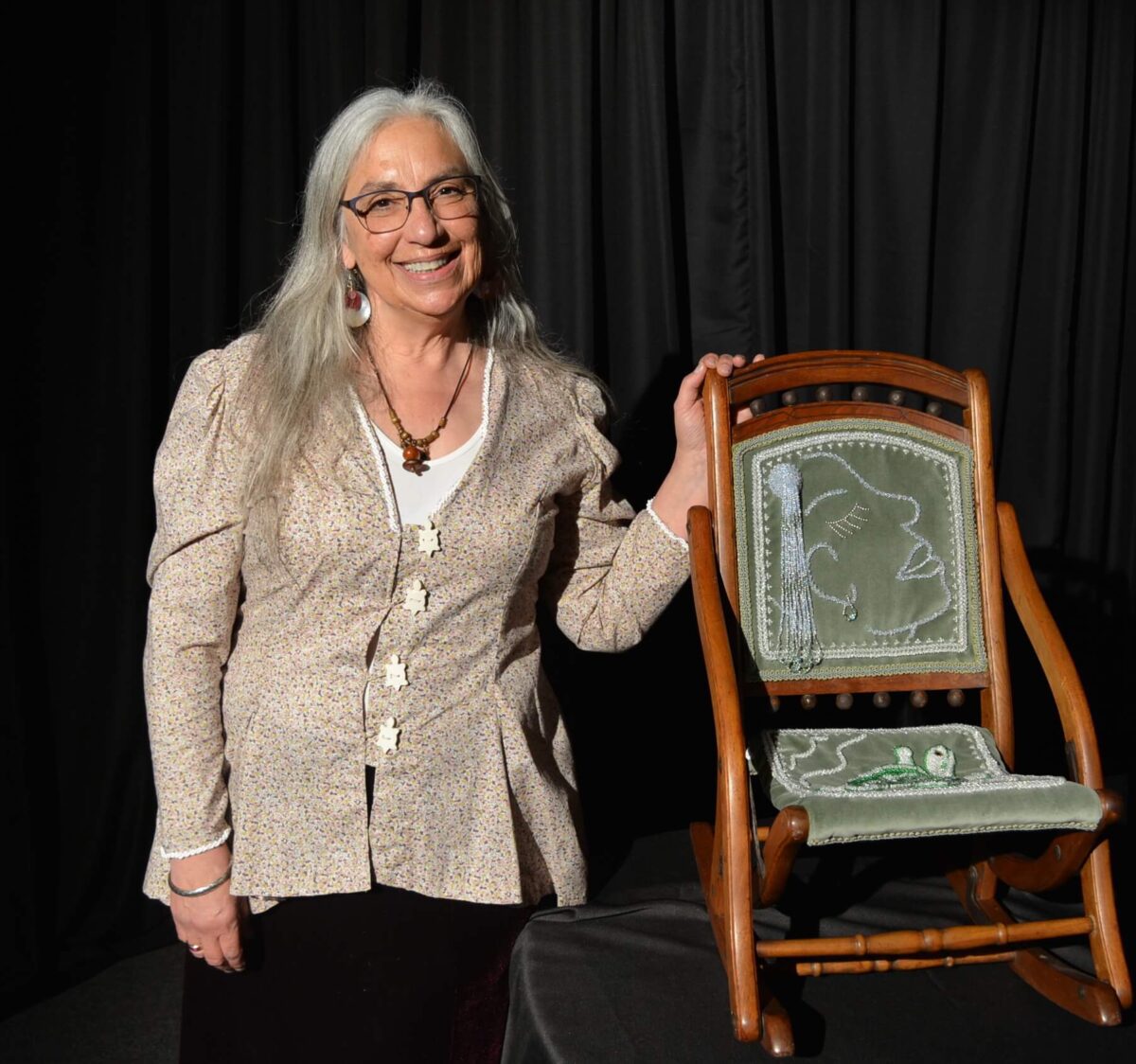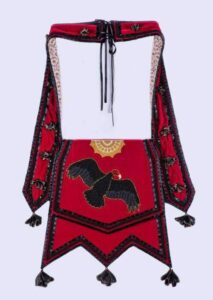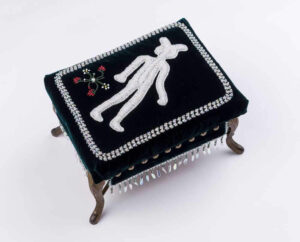
Textiles can tell stories. Picture a dark red shoulder bag embroidered with a large beaded black buzzard, wings outstretched and flying under a sun made of 14k gold beads. The bag shares the Oneida traditional story of a turkey buzzard who flew a great distance to the sun to help get feathers for all birds—and gained respect in the process.

“I told that tradition with a needle, thread, scrap of velvet, some glass beads and in this case gold beads from my teacher,” says Karen Ann Hoffman, renowned Iroquois raised beadwork artist and member of the Oneida Nation of Wisconsin, one of the six nations of the Haudenosaunee Confederacy, also known as the Iroquois Confederacy.
In June, Hoffman was awarded the nation’s highest honor in folk and traditional arts—a National Endowment for the Arts (NEA) National Heritage Fellowship. In September, she’ll keynote at the Wisconsin Regional Art Program (WRAP) State Day Conference, where they will celebrate eight decades of supporting nonprofessional artists across Wisconsin.
“This award is built on the talent of Haudenosaunee artists from very far into our past, those currently practicing and those who haven’t even been born yet,” Hoffman says of the NEA fellowship. “There is so much talent and has been for thousands of years. It’s a great responsibility and a great honor.”
Sharing her work at statewide conference
The WRAP 2020 Annual Art Exhibition and State Day Conference will be held online September 18-20, featuring an art exhibition, demonstrations and networking spaces in addition to Hoffman’s much-anticipated keynote on Iroquois raised beadwork, an art form specific to the Indigenous nations and cultures of the Eastern Great Lakes Region utilizing forms and designs that reach back more than 10,000 years. First executed with bone and shell, later with moose hair and hide, now with glass beads and velvet; the art is a living material language that preserves Haudenosaunee culture.
“Iroquois raised beadwork is elevated and rides high and proud,” Hoffman says. “This mounding nature and piled-on opulence are what makes it distinctive and rich. It’s a celebration of abundance.”

Hoffman’s beadwork is in permanent collections all over the U.S., including at the Smithsonian Institution-National Museum of the American Indian, Chicago’s Field Museum and the Wisconsin Historical Museum. An advocate of Native arts, she’s curated shows across the state, sits on the Wisconsin Arts Board and chairs the Woodland Indian Arts Initiative.
She credits her teachers Samuel Thomas and Lorna Hill of the Lower Band of the Cayuga-Six Nations’ Grand River Reserve, in Canada, with taking her under their wings and teaching her Iroquois raised beadwork in the 1990s—the techniques and patterns, but also the responsibility that goes with deeply investing your life in this art form. She describes her work as being in the Thomas Hill style: beads raised to a particular height, a select color palette, strong connections to the past, quality materials and strictly connected to story.
Hoffman intends to create an engaging talk for the WRAP conference: “I hope people will be able to join me for a little bit of song, a little bit of story, a little bit of looking at some pretty pieces of beadwork and exploring what they are beyond pretty. Pretty is good but there is much more. And I would love to hear questions. I want it to be conversational.”

Other topics for the 2020 conference include: creative art journaling, tips on being a professional artist, use of positive and negative space in image development, sculpture, the art of arranging objects, tips and tricks for acrylic pours and box-making The conference will also include a talk with art museum curators and professionals from the James Watrous Gallery, the Trout Museum of Art, the Center for the Visual Arts and the Chazen Museum of Art.
“We invite artists at all levels, as well as their families, to participate together, listen to professionals and learn a new skill that might spark your creativity.” says Angela Johnson, WRAP director, adding that with registration, participants get access to recordings of all workshops and presentations.
Celebrating 80 years of art in Wisconsin
The Wisconsin Regional Art Program encourages nonprofessional, student and emerging artists to create and exhibit their work across the state at local WRAP exhibitions and workshops. Award winners from local exhibitions have their work shown at the State Day Conference.

Founded in 1940 as an arts-based outreach program of the College of Agriculture to foster rural Wisconsin artists, WRAP was originally called the Rural Art Program. It supported adult, noncredit students as a group of largely self-taught artists—teachers, mail carriers, blacksmiths, farmers and homemakers residing in various small communities. The program now engages any rural or urban nonprofessional artist 14 and older interested in expanding their creative growth in the visual arts.
The WRAP conference sponsors include the Association of Wisconsin Artists (formerly the Wisconsin Regional Artist Association), the Anonymous Fund and UW–Madison Continuing Studies. For more information, contact Angela Johnson at angela.johnson@wisc.edu or visit the WRAP conference website.